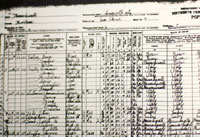Primary Sources » Census
 The
US government has conducted a census every ten years, beginning with
the first census in 1790. Census takers, hired by the government,
travel door to door to ask questions of each household ranging from
occupation to birthplace and race. The handwritten notes of these
census takers are preserved by the National Archives and are known as
the US Manuscript Census.
The
US government has conducted a census every ten years, beginning with
the first census in 1790. Census takers, hired by the government,
travel door to door to ask questions of each household ranging from
occupation to birthplace and race. The handwritten notes of these
census takers are preserved by the National Archives and are known as
the US Manuscript Census.
These are remarkable historical documents because they allow us to
see different periods in rich, local detail. With the Manuscript
census it is possible to see, for example, when women in Winthrop
first worked outside the home in large numbers, and when immigrants
from Ireland and Italy first arrived in Somerville.
As part of a workshop we held in October 2006 on using the
Manuscript Census, we followed one street in Medford through the 1900
and 1930 censuses. We chose Jerome Street because it is the heart of
the black community in West Medford and we were interested in looking
for evidence of the Great Migration, when thousands of blacks from the
south moved north during WWI. By tracking the place of birth of Jerome
Street residents in 1900 and 1930, we were able to see how some moved
from the south to West Medford as part of the Great Migration. And by
tracking track trends in work, home ownership, and literacy, we could
begin to piece together the experience of those who settled in Medford.
The Manuscript Census is available to teachers, students, and
researchers at the National Archives in Waltham, MA. The same material
is also available for a fee through ancestry.com. Because these
documents contain individual names and addresses, the National
Archives and ancestry.com observe a 70-year privacy rule. This means
that only the 1790-1930 manuscripts are available to researchers. The
1940 census will be released in 2010. Because street names were first
included in the 1900 census, the 1900, 1910, 1920, and 1930 Manuscript
censuses will be particularly useful to teachers and students
researching their community�s history.
In addition to the Manuscript Census, the Census Bureau publishes
bound volumes of aggregate data. These volumes are comprised mostly of
tables describing the US population at the level of cities, states and
the nation as a whole. Available for each decade in most libraries,
they offer a view of broad trends in American history.
Census Data can be used as the basis of a long term project or it
can also be used for a one-day lesson. Jen Droney's class in Winthrop,
for example, examined the 1900 and 1930 Winthrop census to track
trends in women's work.

